How do you prevent it ?
- The chain of infection
- To appreciate how the disease can be controlled if not eliminated it helps to understand something of
the chain of events leading to infection.
Quite simply put the chain of infection comprises four steps :
- multiplication
- aerosol formation
- inhalation
- susceptibility
1) Multiplication
Temperature is a crucial factor in the growth and proliferation of the bacteria.
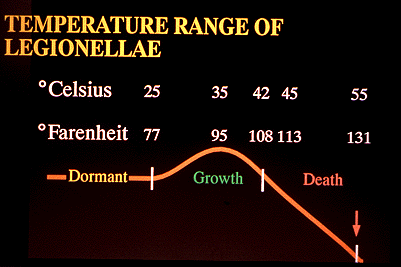
Below 15oC the bacteria is virtually dormant and proliferation ceases.
However in this phase it can survive in tap water for over a year and in distilled water for over four months.
Above 46oC pasteurisation begins, above 60oC it is rapidily killed off, but can survive for short periods of time at up to 80oC.
The optimum temperature for environmental isolates is 30oC.
Availability of nutrient is the next most important factor. As with most bacteria amino acids form
the primary source of carbon and energy. Legionella is known to have a special need for the amino
acid Cysteine. It will not grow without it.
It grows better in slightly acid conditions (pH 6 - 7), but note that this does not prevent its growth in alkaline waters eg cooling towers, evaporative condensers etc.
It requires the presence of traces of metallic elements (such as Fe, Cu, Mg and Mn). Iron is known to be particularly beneficial
up to levels of 50mg/litre.
The numbers of bacteria required to cause legionnaires' disease are not known.
2) Aerosol Formation
Aerosol is a term used to describe a suspension in a gaseous medium of solid or liquid
particles. In particular solid or liquid particles having negligible falling velocity.
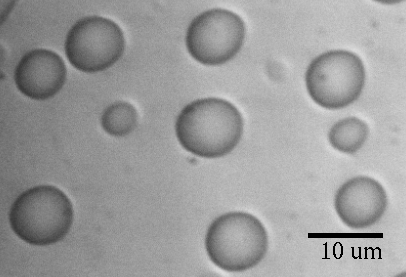
Aerosols of water droplets can be formed by :
- Condensation on nuclei
- When an airstream saturated with water vapour is cooled condensation of water will take place on
tiny particulates present in the air, eg. cooling towers, evaporative condensers.
- Breakup of water jets, drops & films
- Free falling water will tend (as a result of surface tension effects) to break up forming water droplets, eg.
showers, cooling towers, evaporative condensers, spray humidifiers, car washes, water falls,
ornamental fountains etc.
- Wave generation
- Air blown across a water surface generates waves. At a critical velocity the waves become rough
and generate water droplets through splashing.
- Bubbles bursting
- Bubbles are notable for collecting particulates on the inner air/water boundary of the bubble as it
moves through the bulk of the liquid. This provides for an enrichment factor leading to the formation
of water droplets which are more contaminated than the bulk of the liquid from which they are
derived, eg. spa baths, whirlpool baths, jacuzzis.
Drop Size
Size is important. The size of water drops is of critical importance in the chain of infection.
- Stability of the aerosol ;
- As droplet size decreases terminal velocity decreases. So at a certain point the droplet behaves very much
like the bulk of the air surrounding it. For water droplets this point is reached at 5 micron or less.
- Penetration to deep within the lungs ;
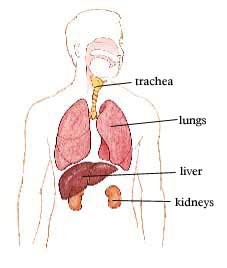
The smaller the droplets of water the further and deeper into the lungs they will travel.
3) Inhalation
Legionnaires' disease requires exposure to a high (but unknown) number of the bacteria. These must be inhaled deep into the lungs.
Since legionella is a waterborne bacteria dispersal of the bacteria is by means of an aerosol of airborne water droplets.
N.B. Inhalation of potting soil has been proposed for a number of cases. 'Groundforce' beware !
Our lungs contain approximately 300million air 'sacs', each of approximately 75 - 300 micron diameter.
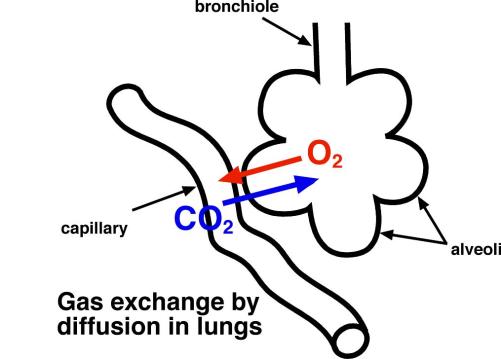
These 'sacs' are called the alveoli.
The lining or membrane of the alveoli separates our blood stream from the air in the lungs.
Air reaches the alveoli through a network of tubes of decreasing diameter.
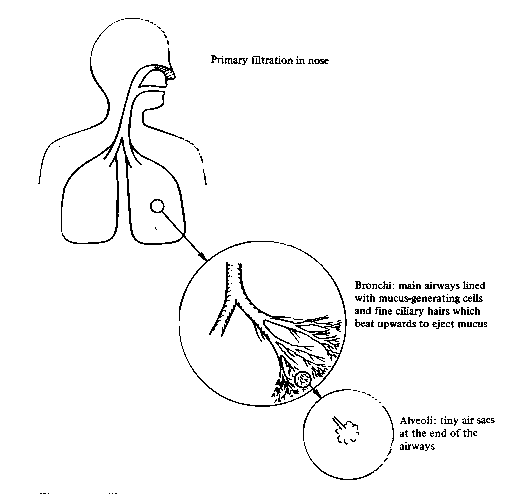
On the way 'down' airborne water droplets can be trapped by :
-
Filtration ;
- Nasal hair removes larger particulates and droplets. 100% of those greater than 10microns in diameter.
- Inertial Impact ;
- Repeated division and changing direction of air flow means that larger particles impact on and are retained
by the mucus lining of trachea and bronchii.
- Ciliary Cleaning ;
- The particles that are trapped on the larger airways are moved by the lining of very fine hairs (called cilia) towards the mouth.
Except where they are not beating due to tobacco smoke. This 'ciliary cleaning' keeps the healthy lung clean and free of bacteria.
So particulates small enough to proceed with the air flow and which have not been filtered and/or
trapped will proceed to the alveoli. Once there, if they do not diffuse out they will sediment out and remain in the alveoli in intimate contact with the blood stream. Once on the lung tissue they can only be removed by ingestion or isolated by building protective
coating/tissue around them.
The critical size is 2 - 5 micron. Any smaller and they are too small to contain the bacteria. Any larger
and they are too big to penetrate into the alveoli.
The number of droplets which require to be inhaled, the number of bacteria required to be present to
cause infection is not known.
4) Susceptibility of the exposed population
Unlike Pontiac fever, or variations of it, which affect practically the whole of the population,
Legionnaires' disease is essentially a disease of susceptibility.
It affects less than 5% of the population exposed, and in some cases exposure to the contamination has only been for a few
minutes.
The predisposing factors are :
Age
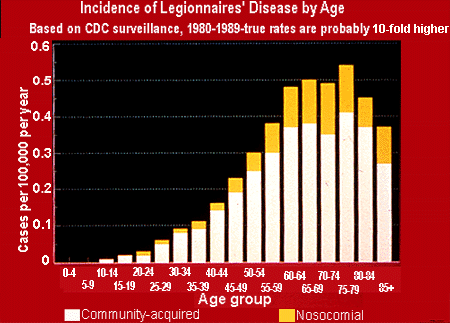
Peak susceptibility occurs between 50 and 70 years.
Gender
- Males are twice as likely to catch the disease as females.
Smokers
- Smokers are more susceptible and this is attributed to the poor state of their lungs.
Illness
- People already ill are less resistant to the disease. As are people on steroids or other
immunosuppressant drugs.
To summarise :
Preventing infection requires that at some point the chain of infection is broken.
To take the chain in reverse order :
- 4) susceptibility ;
- unless we people the world with females, under 40, non - smoking and in
perfect health susceptibility is a 'fact of life'. More importantly it must be taken into account in
the preparation of any assessment of risk (as required by ACOP L8).
- 3) inhalation ;
- unless we take showers or enter the jacuzzi wearing positive pressure respiration apparatus or use filters
sufficiently fine to take out water droplets of 5 micron and smaller inhalation is a 'fact of life'.
- 2) aerosol formation & dispersal ;
- more action can be taken here.
Where evaporative cooling towers are in existence or new ones are being put in high efficiency drift eliminators will remove all but a very very small proportion of the 'drift' ie water droplets formed within cooling towers. But again there is a limit. They are not 100% effective and that still leaves other plant such as showers where dispersal can not be eliminated.
- 1) multiplication ;
- this is the one step in the chain of infection where a wide variety of actions can be taken to
eliminate the risk or control it to a point which is acceptable.
Much of the regulation, codes of practice & guidance to do with legionellosis, centres on control, routines and practice that focus on preventing the proliferation of the legionella bacteria.
Action to be taken can be summarised as follows :
Manufacture > Management > Maintenance > Monitoring
| 




